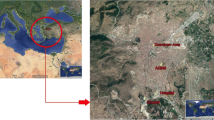Abstract
At present, many rural enterprises in China's mountainous areas are developing rapidly, and due to poor planning and improper management, in an uncontrolled manner. These small enterprises are making atmospheric pollution far more serious and more difficult to control than before. Thus, as is the case with most developing countries, China is facing the challenge of managing the increased environmental pollution that is accompanying its economic development. This paper examines the case of cement dust pollution in the town of Wenquan in Sichuan province in order to determine how to adjust the relationship between development of rural enterprises and atmospheric environmental pollution in mountainous areas. Using the single objective linear programming method, and based on the principle of overall optimization, an optimal control plan for different pollution sources was worked out and an economic assessment on reclamation of cement dust was completed. According to our analysis, after implementation of this plan for four years, two months, the concentrations of suspended particles in Wenquan will achieve the requirement of the national third-order ambient air quality standard; the current serious dust pollution will be completely controlled; and the reclamation of cement dust will totally compensate for the cost of dust control and will result in 92,000 yuan of pure profit per year. At that time, the economy and environment will be in harmony.
Similar content being viewed by others
Literature Cited
Haith, D. A. 1982. Environmental system optimization. John Wiley & Sons, New York, 306 pp.
Ma, D. G., and others. 1985. Control engineering of atmospheric pollution, Chinese Environmental Science Publishing House, Beijing, pp. 86–160.
Ning, D. T. 1989. Mountain area development and environmental carrying capacity for atmospheric pollutants. Pages 122–131in Collected works of environmental science. Chinese Environmental Science Publishing House, Beijing.
Ning, D. T. 1990. Impact of industry development on ambient air quality in Kaixian County. Pages 160–167in Y. N. Liu, D. T. Ning and S. F. Wang (eds.), Research on the environmental carrying capacity of migrated population of Kaixian County. Beijing Normal University Press, Beijing.
Qu, G. P. 1984. The environmental problems and strategies of China. Chinese Environmental Science Publishing House, Beijing.
Zhang, Y. 1986. Impact of air pollution on agro-environment and estimation of its economic cost.Environmental Sciences (China) 7(6):82–86.
Author information
Authors and Affiliations
Rights and permissions
About this article
Cite this article
Ning, D., Li, H. & Yang, X. Particulates pollution management and economic analysis of small rural enterprises in mountain areas: A case study of Wenquan town in China. Environmental Management 18, 175–181 (1994). https://doi.org/10.1007/BF02393760
Issue Date:
DOI: https://doi.org/10.1007/BF02393760




